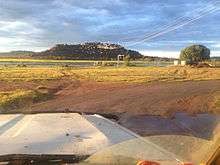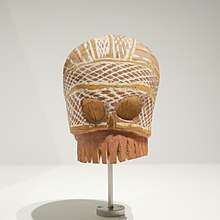Gunbalanya, Northern Territory
Gunbalanya (also spelt Kunbarlanja, and historically referred to as Oenpelli) is an Aboriginal community in west Arnhem Land in the Northern Territory of Australia. The main language spoken in the community is Kunwinjku. At the 2011 census, Gunbalanya had a population of 1,174.[1]
The large and uncommon Oenpelli python, Morelia oenpelliensis, shares the historic name of this community.[2]
Etymology
The area now known as Gunbalanya was originally called "Uwunbarlany" by Erre-speaking people who were its original inhabitants.[3] Oenpelli was the way Paddy Cahill (1863–1923),[4] the founder of the original cattle station in the area, pronounced the local word.[5] The present toponym is an anglisation of the word Kunbarlanja[6] current in Kunwinjku, the language of the people who now live there, who began moving into the area from the east following the Cahill's establishment of his cattle station there in 1909.
Access
The sealed Arnhem Highway links Darwin to Jabiru, the town within Kakadu National Park. About four kilometres before Jabiru, the sealed road turns off to Ubirr, the Border Store, Cahills Crossing on the East Alligator River and Oenpelli. The road is dirt from the East Alligator to just before Gunbalanya, a distance of about 16 kilometres. While this road is generally navigable by four wheel drive vehicle, the river crossing is a causeway which is closed by flooding during the wet season (November to April) and at high tides.
Dry season travellers are able to drive the 300 km from Darwin in about three hours and 60 km from Jabiru in under an hour. Northern Land Council permits are required to cross the East Alligator River, the western boundary of Arnhem Land, and travel east to Gunbalanya.
Oenpelli Airport is a sealed all weather airstrip located in Gunbalanya, and a number of companies offer charter flights to and from this airport.
The local radio station is called "RIBS" for Remote Indigenous Broadcasting Service.
Climate
| Climate data for Oenpelli (Gunbalanya) | |||||||||||||
|---|---|---|---|---|---|---|---|---|---|---|---|---|---|
| Month | Jan | Feb | Mar | Apr | May | Jun | Jul | Aug | Sep | Oct | Nov | Dec | Year |
| Record high °C (°F) | 38.1 (100.6) |
39.0 (102.2) |
38.8 (101.8) |
38.8 (101.8) |
37.0 (98.6) |
37.5 (99.5) |
36.5 (97.7) |
39.0 (102.2) |
39.7 (103.5) |
42.2 (108.0) |
41.9 (107.4) |
39.9 (103.8) |
42.2 (108.0) |
| Average high °C (°F) | 33.1 (91.6) |
32.5 (90.5) |
32.9 (91.2) |
34.0 (93.2) |
33.3 (91.9) |
32.1 (89.8) |
32.1 (89.8) |
33.7 (92.7) |
35.9 (96.6) |
37.5 (99.5) |
37.1 (98.8) |
34.9 (94.8) |
34.1 (93.4) |
| Average low °C (°F) | 24.5 (76.1) |
24.5 (76.1) |
24.4 (75.9) |
23.6 (74.5) |
21.9 (71.4) |
19.7 (67.5) |
18.3 (64.9) |
18.5 (65.3) |
20.1 (68.2) |
22.4 (72.3) |
24.1 (75.4) |
24.5 (76.1) |
22.2 (72.0) |
| Record low °C (°F) | 17.5 (63.5) |
21.0 (69.8) |
17.9 (64.2) |
17.0 (62.6) |
10.0 (50.0) |
10.0 (50.0) |
4.4 (39.9) |
9.2 (48.6) |
11.1 (52.0) |
13.1 (55.6) |
18.0 (64.4) |
12.5 (54.5) |
4.4 (39.9) |
| Average rainfall mm (inches) | 340.9 (13.42) |
335.2 (13.20) |
279.6 (11.01) |
83.6 (3.29) |
14.0 (0.55) |
1.6 (0.06) |
2.2 (0.09) |
1.0 (0.04) |
4.7 (0.19) |
25.8 (1.02) |
110.1 (4.33) |
224.7 (8.85) |
1,414 (55.67) |
| Average rainy days | 20.5 | 19.5 | 18.1 | 6.9 | 1.7 | 0.4 | 0.3 | 0.2 | 0.7 | 2.6 | 9.3 | 16.4 | 96.6 |
| Source: [7] | |||||||||||||
Tourism


Permits for road travel into Arnhem Land can be organised at the Northern Land Council offices in Darwin or Jabiru and may take up to two weeks to finalise. Many visitors prefer to see Arnhem Land through an organised tour operation.
The Stone Country Festival (formerly Gunbalanya Cultural Open Day) is usually held in August and access for this is allowed without permit. Though an annual event, it is sometimes not able to be organised in a given year.
Rock art
Western Arnhem Land is home to some of the most significant rock art in the world. It has arguably the world's longest continuing artistic traditions - with rock art dating back thousands of years and still being produced today.
Local artistic traditions are continued and adapted by the Injalak Arts Centre. Injalak Arts is named after nearby Injalak Hill, which has many rock art galleries and is the main tourist attraction in Gunbalanya.
Bark art
In the 1960s the mission at Oenpelli encouraged traditional rock painting artists to paint on bark. These painted barks were sold to anthropologists and travellers. This soon became a cottage industry and several important aboriginal artists including Lofty Bardayal, Mick Kubarrku[8] and Dick Murramurra[9] transferred their rock art skills to bark. These bark paintings are now held in Australian and overseas art galleries. Exhibitions of Bark paintings include Old Masters[10] at the National museum of Australia and Crossing Country[11] at the Art gallery of New South Wales.
History
Oenpelli, as it was known then, was established by the Rev Alfred Dyer as a mission in 1925 by the Church of England's Church Missionary Society, on the former cattle station.[12] Dyer and his wife Mary established a typical mission station, with church, school, dispensary, garden and store, to which they added pastoral work with feral cattle and horses. Among those who attended the mission school was the celebrated Gagudju elder and interpreter of culture, Bill Neidjie.[13]
Oenpelli remained a mission until 1975, when responsibility was transferred to an aboriginal town council and the name was changed to Gunbalanya.
The 1948 American-Australian Scientific Expedition to Arnhem Land visited Oenpelli for three months and collected a large array of local artefacts, art, and specimens.
Notes and references
Notes
- Gunbalanya 2016.
- Beolens, Bo; Watkins, Michael; Grayson, Michael (2011). The Eponym Dictionary of Reptiles. Baltimore: Johns Hopkins University Press. xiii + 296 pp. ISBN 978-1-4214-0135-5. ("Oenpelli", p. 193).
- Birch 2011, p. 313, n.3.
- Clinch 1979.
- Mulvaney 2004, p. 37.
- Garde, Murray. "Kunbarlanja". Bininj Kunwok online dictionary. Bininj Kunwok Regional Language Centre. Retrieved 16 June 2019.
- "Oenpelli". Climate statistics for Australian locations. Bureau of Meteorology. Retrieved 26 November 2011.
- "Mick Kubarrku oenpelli Artist | Mick Balang Kubarrku | sell Kubarrku". Aboriginal Bark Paintings. 26 October 2017. Retrieved 3 January 2019.
- "Dick Murramurra | Dick Murramurra Nguleingulei | sell Dick Murramurra". Aboriginal Bark Paintings. 28 September 2017. Retrieved 3 January 2019.
- "National Museum of Australia - Old Masters: Australia's great bark artists". www.nma.gov.au. Retrieved 3 January 2019.
- "crossing country". www.artgallery.nsw.gov.au. Retrieved 3 January 2019.
- Mulvaney 2004, p. 58.
- Mackinolty 2002.
References
- Birch, Bruce (2011). "The American Clever Man (Marrkijbu Burdan Merika)". In Thomas, Martin; Neale, Margo (eds.). Exploring the Legacy of the 1948 Arnhem Land Expedition. Australian National University. pp. 313–335. ISBN 978-1-921-66645-2.CS1 maint: ref=harv (link)
- Clinch, M. A. (1979). "Cahill, Patrick (Paddy) (1863–1923)". Australian Dictionary of Biography. 7. Melbourne University Press.CS1 maint: ref=harv (link)
- Mackinolty, Chips (17 June 2002). "The man who attended his own wake:Big Bill Neidjie, Kakadu Man, circa WWI-2002". The Sydney Morning Herald.CS1 maint: ref=harv (link)
- Mulvaney, Derek John (2004). Paddy Cahill of Oenpelli. Aboriginal Studies Press. ISBN 978-0-855-75456-3.CS1 maint: ref=harv (link)
- "Gunbalanya". West Arnhem Regional Council. 2016.
Further reading
- Birch, Bruce 'Erre Mengerrdji Urningangk: Three Languages From The Alligator Rivers Region Of North Western Arnhem Land, Northern Territory, Australia', Gundjeihmi Aboriginal Corporation, 2006
- Aboriginal Arts Board of the Australia Council, Oenpelli Bark Painting, Ure Smith, 1979
- Cole, Keith, A History of Oenpelli, Nungalinya Publications, 1975
- Cole, Keith, Arnhem Land: Places and People, Rigby, 1980
External links
- West Arnhem Regional Council
- Injalak Stone Country Arts and Crafts
- West Arnhem College Gunbalanya
- Northern Land Council
- Kunwinjku language
- Online Kunwinjku dictionary